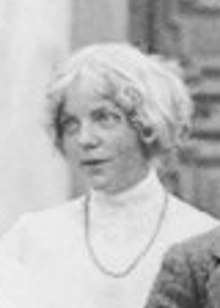Anne Marie Telmányi
Anne Marie Frederikke Telmányi née Nielsen (1893–1983) was a Danish painter and writer. In addition to landscapes and mythological subjects, she is remembered in particular for her portraits of important figures of the times. Her writings include a biography of her mother, Anne Marie Carl-Nielsen, who was also an artist.[1] Her father was the composer Carl Nielsen and husband was the Hungarian violinist Emil Telmányi.[2]

Biography
Born in Copenhagen on 4 March 1893, Anne Marie Frederikke Nielsen, familiarly known as "Søs", was the daughter of the celebrated composer Carl Nielsen (1865–1931) and his wife, the sculptor Anne Marie Brodersen (1863–1945). She grew up in a home rich in culture as her father composed on the piano and her mother worked in her studio. In her book Mit barndomshjem (My Childhood Home 1965), she fondly describes how her father frequently played with the three children.[1] She had an elder sister, Irmelin (1891–1974), and a younger brother, Hans Børge (1895–1956), who was handicapped after suffering from meningitis.[3][4]
Interested in drawing during her early childhood, Nielsen received her first formal lessons at the art school run by Julie Meldahl and Charlotte Sode. She entered the Royal Danish Academy of Fine Arts in 1909 when she was only 16 but was sent to a boarding school in England a year later. After returning to the Academy in 1912, she graduated in 1916. The same year she was awarded the Academy's gold medal for a pietà.[1][5]
Anne Marie Nielsen first exhibited at the Charlottenborg autumn exhibition in 1917. The following year she married the Hungarian virtuoso violinist Emil Telmányi (1892–1988) who had specialized in her father's compositions. For some years, she accompanied her husband on his concert tours of Europe, often painting landscapes of the places they visited.[1]
From 1925 to 1926, Telmányi continued her studies in Paris at the Académie Moderne studying under Othon Friesz and Fernand Léger. Thereafter, her paintings displayed greater integration of light and colour. In 1933, she was commissioned to decorate the staircase at the Royal Music Academy. She completed four portraits, employing a difficult wax technique but her work is no longer accessible. Her figurative work included landscapes and mythological motifs but she is remembered above all for her portraits of celebrated figures such as the modernist painter Olivia Holm-Møller, the actress Bodil Ipsen, the opera singer Else Brems and the archaeologist Peter Glob. She also painted a number of self-portraits.[1]
In 1936, after her marriage was dissolved, she moved in with her mother until her death in 1945. She developed her friendship with Else Vogel-Sørensen, whom she had met at the Academy. The two exhibited together from the 1930s to the 1950s. In 1961, she joined the Aurora group of artists based on the island of Møn and contributed to their exhibitions which toured Denmark. In 1957, Fyns Kunstmuseum (Art Museum of Funen) presented a retrospective exhibition of her work.[1]
She wrote a biography of her mother, Anne Marie Carl-Nielsen 1979. Also in 1979, together with her sister Irmelin Eggert Møller, she created a sizeable foundation with the funds they had inherited from their parents. They established two awards, one for musicians and sculptors known as the Carl Nielsen and Anne Marie Carl Nielsen Legat, the other in support of female artists aged more than 40, the Anne Marie Telmányis Legat.[1]
Anne Marie Telmányi died in Hørsholm on 17 April 1983 and is buried in Copenhagen's Vestre Cemetery.[1][5]
Publications
- Telmányi, Anne Marie (1965). Mit barndomshjem : erindringer om Anne Marie og Carl Nielsen skrevet af deres datter [My Childhood Home: memories of Anne Marie and Carl Nielsen written by their daughter] (in Danish). Copenhagen: Thaning & Appel. OCLC 1005901264.
- Telmányi, Anne Marie (1979). Anne Marie Carl-Nielsen (in Danish). Copenhagen: Gyldendal. ISBN 87-01-84801-1.
References
| Wikimedia Commons has media related to Anne Marie Telmányi. |
- Bruselius, Lis. "Anne Marie Telmányi (1893 - 1983)" (in Danish). Kvinfo. Retrieved 15 November 2017.
- Schultz, Sigurd. "Anne Marie Telmányi" (in Danish). Gyldendal: Den Store Danske. Retrieved 15 November 2017.
- "Family life". Carl Nielsen Society. Retrieved 15 November 2017.
- "Carl August Nielsen". Carl August Nielsen. Retrieved 15 November 2017.
- "Anne Marie Telmányi" (in Danish). Kunstindeks Danmark & Weilbachs Kunstnerleksikon. Retrieved 16 November 2017.